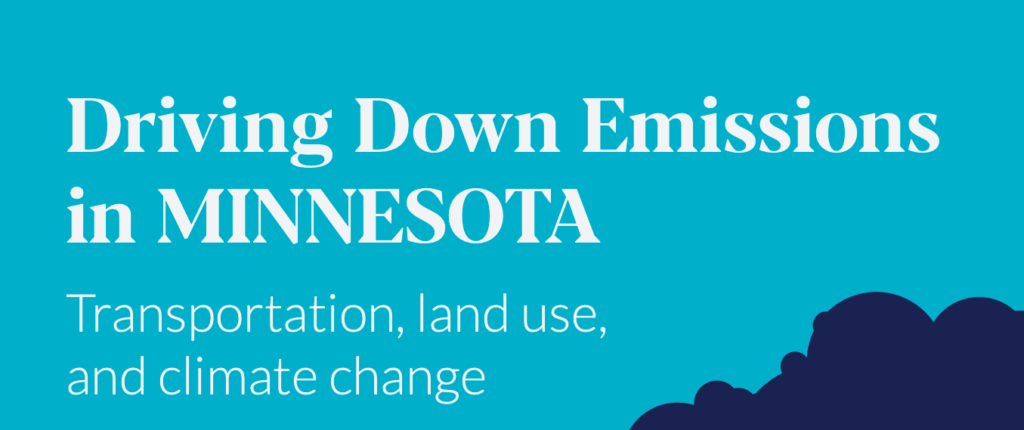Driving Down Emissions in Minnesota
State and local policymakers have an important role to play in making it possible for people to drive less, which is essential for lowering transportation emissions. With our partners at Move Minnesota we produced a new case study companion to Driving Down Emissions looking at how Minnesota has seen some success reducing transportation emissions, why that progress won’t be sufficient, and how to stop leaving valuable strategies to create more livable and equitable communities on the table.

Our new report, Driving Down Emissions, identifies strategies that can help make a significant dent in growing transportation emissions while building a more just society simply by allowing Americans to drive less to accomplish daily needs. While national policy changes will be needed to address that goal, many state and local governments continue to create barriers by over-investing in new highway infrastructure and imposing onerous government regulations that make it nearly impossible to build more housing in walkable and transit-accessible places.
There is a lot that other states could learn from Minnesota. The state and its localities have taken a number of valuable steps to make it possible to drive less. Yet Minnesota also faces challenges common to many other states—including an overreliance on future electric vehicles to reduce emissions at the expense of strategies that can be used right now to help people get around outside of a car.
Read on for a summary of our Minnesota case study, and download the full version here.
The good news: progress reducing transportation emissions, and clear opportunities to do more
Minnesota has had some success reducing emissions from the transportation sector in recent years, particularly compared to some of its peers. The state’s annual transportation emissions peaked in the mid-2000s and then dropped 13 percent between 2005 and 2009. The state achieved this reduction partially by keeping driving per person in check, with annual miles driven per-person declining slightly between 2005 and 2017 (total miles driven annually has risen slightly). Minnesota has maintained that lower level since in contrast to national transportation emissions which began to climb since the last recession.
Minnesota also has a solid foundation to do more to make it possible for residents to drive less. The Twin Cities region (home to 65 percent of the state’s population) has made several strategic investments in light rail and bus rapid transit expansion, and has seen ridership increase on those lines in contrast to declining transit ridership elsewhere in the U.S. Outside of the Twin Cities, communities from Alexandria to Biwabik have made real progress making their streets safer for walking and biking, thanks in part to the state’s Complete Streets program and related initiatives.
The City of Minneapolis passed a comprehensive plan in 2018 to allow the addition of more housing in neighborhoods throughout the city while eliminating parking requirements, changes that have the potential to make a significant impact. In most urban areas in the U.S., the supply of affordable housing in walkable, transit-accessible neighborhoods is artificially constrained by government-mandated zoning requirements. Removing those restrictions will allow more housing in the region and make it more affordable to live in the city, mitigating future sprawl and the additional driving it would cause while addressing a continued source of economic and racial discrimination in the region.
Leaving valuable strategies on the table with an over reliance on electric vehicles
Despite those successes, Minnesota’s progress is just a start, and the state is not currently on track to meet its emissions reductions targets. Like many states, Minnesota has a legacy of prioritizing highway infrastructure that continues to have lasting impacts without further change. Sprawl continues to force more driving—in fact, the counties surrounding the Twin Cities are the main contributor to the state’s overall growth in driving annually.
Unfortunately the Minnesota Department of Transportation’s (MnDOT’s) plans for decarbonizing the transportation sector largely downplay reducing driving as an option. Instead, they rely heavily on ambitious assumptions about future electric vehicle adoption—and even on as-of-yet undeveloped biofuels technology—despite the fact that Minnesota has lagged behind the national average in adoption of electric vehicles.
This is shortsighted and will lead the state to miss major opportunities. It also won’t address the needs of Minnesotans who can’t afford a car or are otherwise unable to drive, perpetuating existing inequities. Reducing the need to drive in Minnesota is not only doable, it’s what many Minnesotans want. Outreach conducted by MnDOT has shown broad public appetite for more walkable and less car-dependent communities. In fact, “walkable and bikeable communities” and “improved public transit” received the greatest support as a decarbonization strategy in MnDOT’s outreach, along with electric buses and trains.
It makes no sense to leave any emissions reduction strategy untouched, especially when Minnesota has had success reducing driving in the past. The state should do more of what it knows works.
Read the full case study.



















